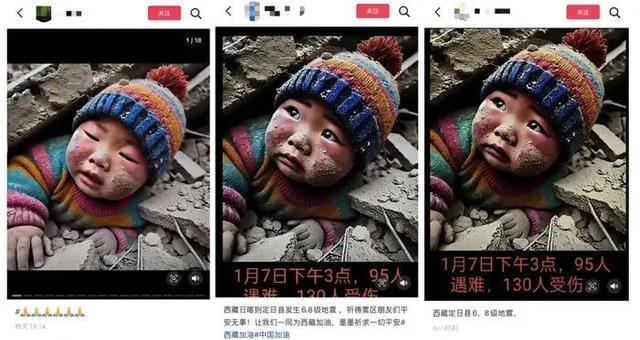AI Earthquake Photo Deception: Trust Crisis in Digital Age
A viral AI-generated image of a trapped boy during Tibet’s earthquake raises concerns about artificial intelligence misuse and misinformation during disasters, highlighting urgent need for regulation and public awareness.

The devastating 6.8 magnitude earthquake that struck Xigaze, Tibet on January 7, 2025, brought not only physical destruction but also unveiled a disturbing trend in digital misinformation. An AI-generated image depicting a young boy trapped under rubble went viral across Chinese social media platforms, garnering millions of shares and reactions from concerned citizens.
The digitally fabricated image, originally created in November 2024, showed a boy wearing a cap pinned beneath collapsed buildings. While the creator had initially labeled it as AI-generated content, subsequent sharing amid the real disaster stripped away this crucial context. The image’s emotional impact overshadowed obvious technical flaws, such as anatomical irregularities in the child’s hands - a common telltale sign of AI generation.
This incident mirrors similar cases worldwide. In October 2024, during Hurricane Helene in the United States, AI-generated disaster images spread rapidly across social media, manipulating public sentiment and potentially diverting attention from genuine relief efforts. These cases demonstrate a growing pattern where artificial intelligence becomes a tool for creating and spreading emotionally charged misinformation.
The spread of such deceptive content creates multiple societal challenges. First, it erodes public trust in genuine disaster reporting and documentation. When people become increasingly skeptical of visual evidence, real victims may struggle to receive necessary attention and aid. Second, these fabricated images can trigger misallocation of emergency resources and humanitarian assistance.
More fundamentally, this trend threatens to exhaust public empathy. When people repeatedly discover their emotional investments were based on artificial constructs, they may become desensitized to genuine suffering. This “compassion fatigue” could significantly impact society’s collective ability to respond to real crises.
Media platforms must implement stronger verification systems and clear labeling of AI-generated content. However, technology alone cannot solve this issue. Public education about digital literacy and critical media consumption becomes increasingly vital in this new era of artificial intelligence.
The incident also highlights the need for regulatory frameworks that balance technological innovation with social responsibility. While AI technology itself is neutral, its misuse during humanitarian crises demands careful oversight and ethical guidelines for content creators and distributors.
Ultimately, protecting public trust and empathy in the digital age requires collaboration between technology platforms, regulatory bodies, media organizations, and an informed citizenry. The power of AI must be harnessed to enhance human connection and aid, rather than undermining the authentic emotional bonds that hold society together.